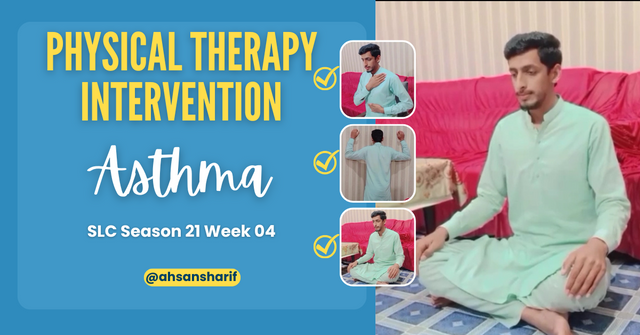Hello Everyone
I'm AhsanSharif From Pakistan
Greetings you all, hope you all are well and enjoying a happy moment of life with steem. I'm also good Alhamdulillah. |
|---|

Design On Canva
What's Asthma? Write in your own words after getting knowledge from the lesson post. |
|---|
Asthma
It is a chronic disease that is manageable and caused by an increase in various triggers. As a result, our airways become narrowed and inflamed, which makes breathing very difficult. It is manageable with proper treatment and can be managed so that a person can live a normal life if they take good and appropriate measures. It is often described as an incurable condition. It can be fatal because it makes it very difficult for us to breathe.
There are many triggers, such as when an asthma patient is exposed to smoke or pollution. The airways in his lungs become blocked, which causes him to become anxious, have difficulty breathing, and cough. His airways swell, and they start producing excess mucus, making it difficult to breathe.
Main Components:
Hypersensitivity:
Asthma results from the overactivity of the immune system. When exposed to various allergens, the immune system reacts very strongly to them, causing inflammation in the lungs easily.
Inflammation:
The airways of such patients quickly become inflamed and start producing excess mucus, which causes great difficulty in breathing.
Types:
Occupational Asthma:
Specific irritations are caused by exposure to various chemicals in our workplace.
Conventional Asthma:
This is also a type of asthma that reacts quite severely to environmental pollution.
Exercise-Indeed Asthma:
This is also a common asthma condition that is triggered by our physical activity, usually in cold or dry conditions.
Symptoms:
Coughing:
It may or may not be involved in mucus production.
Wheezing:
When we breathe, we hear a whistling sound called wheezing.
Shortness of Breath:
Difficulty breathing or difficulty breathing in or out, often this happens suddenly.
Sweating:
Unusual sweating may be associated with an asthma attack or yellowing of the skin.
Asthma Triggers:
Cigarette Smoke:
Both ordinary smoke and smoking trigger asthma attacks.
Respiratory Infection:
A cold or flu can make asthma symptoms worse.
Allergens:
Allergies can be of different types, including dust mites, mold, food allergens, or insects.
Exercise:
Exercising too much in the cold season can also cause asthma.
Air Pollution:
Both indoor and outdoor pollution exacerbate asthma symptoms.
Assessing Asthma:
Chest X-ray:
Chest X-rays are performed to assess the condition of the lungs.
LFT:
LFT stands for Lung Function Test, which measures how well the lungs are working.
ABGs:
ABG stands for Arterial Blood Gases, which measure the amount of oxygen and carbon dioxide in our blood.
Sputum Analysis:
It is used for infections in the mucus or to highlight signs of inflammation.
Special Test:
Spirometry:
This is a specific device used to measure the lungs. It usually measures the volume and speed of air that a patient can exhale.
Asthma Impact Questions:
Questions are asked of the patient, which gives us an idea of how it is affecting their daily life.
Physical Therapy Interventions for Asthma:
Chest physiotherapy is an important part of managing asthma. These treatment plans can last for weeks or even months as the aim is to restore the lungs and reduce symptoms. Physiotherapy helps us to improve our quality of life as we overcome breathing difficulties.
How would you diagnose a asthma? Any clinical investigation or assessment tests? |
|---|
The medical evaluation of an asthma patient involves a set of specific tests that assess the function and responsiveness of the lungs. Healthcare professionals use these tests to determine what symptoms are causing the patient to have this condition and to assess the severity of the condition. We have some specific measures and tests to look for these, which are listed below.
Medical History:
The first thing to do is to ask the patient about their entire medical history including:
Symptom Pattern:
When a patient experiences wheezing, coughing, or shortness of breath, it is important to assess how often they occur or what their cause is.
Family History:
Some diseases run in families, so it would be good to know if anyone in your family or close relatives has such a problem.
Exposure to Triggers:
Then we will identify allergens, including pet dander, or whether exercise, cold air, or respiratory illnesses worsen their condition or worsen their symptoms.
Physical Examination:
Then we will do a physical examination of the patient, which will include a few things:
Lungs & Breathing Sounds:
Using a stethoscope, we listen for wheezing or abnormal lung sounds.
Nasal Examination:
We will examine their nose to see if it is runny or swollen for signs of allergies.
Skin Testing:
Sometimes allergies are included in asthma symptoms, so it is also necessary to get a skin test done to see this.
Lung Function Test:
Spirometry:
This is a common test that allows us to measure the amount of air we can forcefully inhale or exhale in one second through a deep breath.
Peak Flow Measurement:
A peak flow meter is a device through which we measure the ability of a patient's lungs to exhale air rapidly. If the reading is lower than normal, it indicates that the patient's airways are narrow.
Bronchodilator Reversibility Test:
After performing spirometry, we will give the patient a bronchodilator medication to open the airways and then retest. If his lung function is significantly improved, then it indicates asthma.
Additional Test:
Chest X-ray:
Chest X-rays are done to check the lungs to see how well they are working.
Allergy Test:
Additionally, allergy tests are performed to determine if the symptoms of allergies are not associated with asthma because there are some triggers, such as pet dander, that can also trigger allergies.
Sputum Analysis:
It is used because they express infection and inflammation in their mucus.
ABGs:
Arterial blood gases are used to estimate the amount of oxygen and carbon dioxide in the blood.
Asthma Impact Questionnaire:
ACT:
ACT stands for Asthma Control Test, which is designed to help us know how well asthma is being controlled over time.
AQLQ:
AQLQ stands for Asthma Quality of Life Questionnaire. It is used to better assess the impact of asthma on a patient's daily life.
Exercise Challenge Test:
Many people suspect that they have asthma due to exercise, so this test is especially for them because it is done to look at all the lung functions before and after physical exertion. If exercise triggers asthma, then there will be a significant decrease in lung function during and after that activity.
Try to practice at least 3 exercises that you have learned from the lesson. Share images, gifs, or videos while practicing. |
|---|
Before exercising, it is better to take steam or do nebulization because it relaxes our muscles and makes breathing easier. The simple process of taking steam is to boil water and pour it into a large bowl. Put it in the bowl and keep our mouth 10 to 12 inches above it and take a towel from above us through which we have to trap the steam. And for five to 10 minutes, we have to take this steam in through the nose and exhale through the mouth. With such a process, we can make our breathing passages good and better.
This is a home remedy that we can use to improve our respiratory tract. If you have a nebulization device, you can use it by adding a saline solution or as recommended by your doctor. You have to sit comfortably and place it over your nose and mouth and for five to 10 minutes, you have to inhale this misty air through your nose and exhale through your mouth.
After both these methods, your mucus will become soft, and you will expel it during a light cough. Then, you will not have difficulty breathing. After doing either of these two, you have to do breathing exercises, and then you will get an idea of your improvement.
Now I will do three types of exercises here, the video of which is below.
Chest Stretches Exercise
 |  |
|---|
Diaphragmatic Breathing Exercise
 |  |
|---|
Pursed lip breathing exercise
 |  |
|---|
Share your review after performing these exercises either on yourself, a healthy individual, or a patient. |
|---|
After doing all these exercises, I have felt that my breathing passages have opened and I am breathing easily I am satisfied that I do not have any problems and my bones are responding to the stretching it has become easier to breathe here. I have trained the lungs in a good way.
By doing the Diaphragmatic exercise, I placed one hand on my stomach and the other on my chest and performed it, during which I felt that I was making it easier to breathe. This way, timing comes into the breath and I don't get out of breath.
By doing the upper chest stretch, all my bones have responded to it, and through it, my breathing airways have opened up nicely and I am feeling relieved.
In short, by performing these exercises, my airways have opened up nicely and I am breathing in and out easily.
I would like to invite my friends @rumaisha, @ruthjoe, @bossj23, and @waterjoe to join this task.
Cc:
@ashkhan

Your post may point new directions for asthma sufferers. If we all can be aware of this, many lives can be saved. Good luck for the contest.
Downvoting a post can decrease pending rewards and make it less visible. Common reasons:
Submit
Yes absolutely I agree with you. Thanks for the best wishes.
Downvoting a post can decrease pending rewards and make it less visible. Common reasons:
Submit